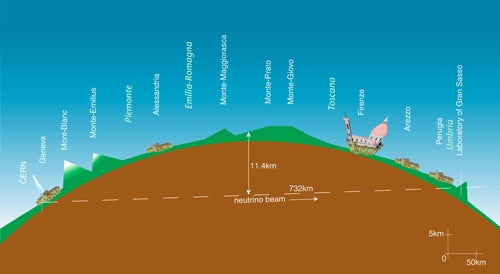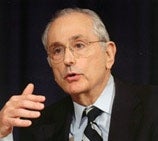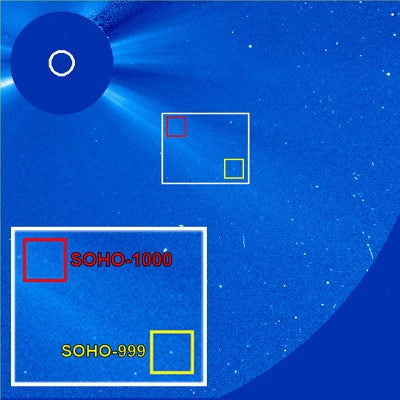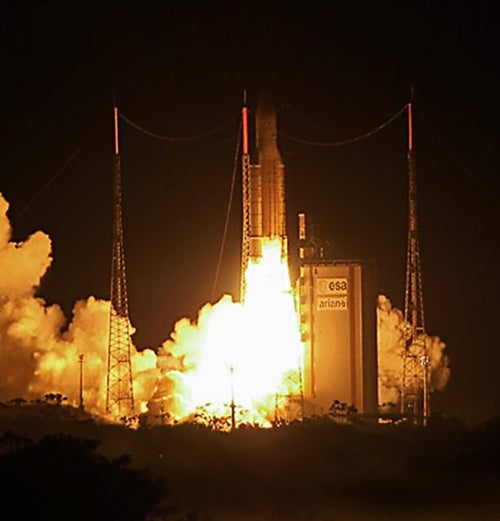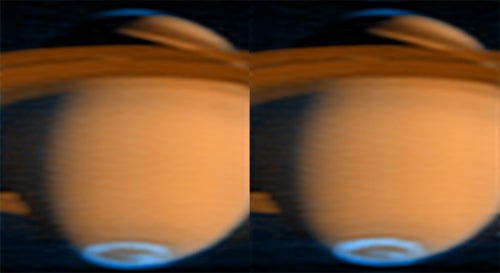One-way trip to Italy
In order to learn more about neutrinos, CERN (the European Organization for Nuclear Research, in Geneva) will beam the elusive particles underground to a laboratory 455 miles (732 kilometers) away. CERN has assembled the detector, which will be placed in the Gran Sasso National Laboratory in Italy. The CERN neutrinos to Gran Sasso (CNGS) project will begin May 2006.
Because there are so many neutrinos in our universe, these particles — a possible dark-matter candidate — may help astrophysicists better understand the universe’s composition. — Liz Kruesi
John Bahcall (1934–2005)
John Bahcall, age 70, passed away August 17 after battling a rare blood disorder.
During his 5-decade career, Bahcall was a prominent and active leader of the astrophysics community, publishing more than 500 works. Bahcall received the National Medal of Science in 1998 and served as president of the American Astronomical Society, president-elect of the American Physical Society, and Richard Black Professor of Astrophysics in the School of Natural Sciences at the Institute for Advanced Study (IAS) in Princeton, New Jersey.
“John Bahcall was a true pioneer in the fields of astronomy and astrophysics. His contributions have had an indelible impact,” recalls Peter Goddard, director of the IAS. “Always generous with his time, John Bahcall was an inspirational teacher and mentor who shaped the careers of a generation of scientists. His passing is deeply felt at the Institute.”
In the 1970s, Bahcall was a proponent for creating an optical space telescope. Thanks to his efforts, the Hubble Space Telescope launched in 1990. Bahcall fought for the endangered observatory’s survival until his death.
Bahcall is survived by his wife Neta and three children. — Jeremy McGovern
The Solar and Heliospheric Observatory (SOHO), history’s most prolific comet-hunter, has bagged its 1,000th dirty snowball. This spacecraft is responsible for finding more than one-half of sungrazing comets with calculated orbits. SOHO continues to surpass early expectations.
Like many other SOHO discoveries, an amateur located the comet. Scouring SOHO images on the Internet, Toni Scarmato, a high-school teacher from Italy, noticed the 999th and 1,000th icy bodies in the same image.
The SOHO team held an online contest allowing visitors to guess the time when the 1,000th comet would reach perihelion — the comet’s closest approach to the Sun. The winner, Andrew Dolgopolov of Dublin, Ireland, predicted the period within 22 minutes.
By correctly guessing the time and date when this comet would make its closest approach to the Sun, Dolgopolov wins a SolarMax DVD, SOHO T-shirt, solar viewing glasses, and a variety of other SOHO materials. Second- and third-place winners also received similar prizes. — Jeremy McGovern
Record satellite gets a lift
When an Ariane 5G rocket blasted off the pad at the European Space Agency’s French Guiana spaceport yesterday, it was carrying the largest telecommunications satellite ever placed into geostationary transfer orbit. The satellite heavyweight, named Thaicom 4, weighed 14,270 pounds (6,486 kilograms) at liftoff.
Space Systems/Loral of Palo Alto, California, built the bird for Shin Satellite PCL of Thailand. The satellite will provide businesses and consumers throughout Asia, Australia, and New Zealand with various levels of Internet access.
The orbiter has a total data-throughput capacity of over 45 gigabits per second through seven onboard antennae, and its solar panels generate 14,000 watts of power. The spacecraft’s expected service life is 12 years. This is the fourth Shin Satellite to be launched by an Ariane vehicle since 1993.
— Francis Reddy
After a 2-day delay, NASA’s Mars Reconnaissance Orbiter (MRO) launched this morning from Cape Canaveral Air Force Station in Florida. When the spacecraft reaches the Red Planet in March 2006, it will explore Mars, concentrating on its water mystery.
Once the spacecraft arrives at Mars, it will slow down and begin orbiting the planet. This 6-month process will allow MRO to dip into the top of the martian atmosphere.
Researchers believe MRO will greatly enhance our understanding of the Red Planet. “Mars Reconnaissance Orbiter will give us several times more data about Mars than all previous missions combined,” says James Graf, project manager for the mission. Graf has reason to be confident — MRO possesses a data-transmission rate 10 times greater than any previous Mars-exploring spacecraft.
The new data will help scientists examine past water presence on the Red Planet. Understanding the history and distribution of martian water will provide insight into the question of life on Mars. The spacecraft also will assist future missions by surveying landing sites and relaying communications between Mars and Earth, such as Phoenix Mars Scout and Mars Science Laboratory, scheduled to launch in 2007 and 2009, respectively. — Jeremy McGovern
Another first for astronaut
Last week, STS-114 Mission Specialist Steve Robinson became the first astronaut to repair a shuttle’s exterior during orbit. One day before returning to Earth, he became a pioneer in another respect: host of the first podcast from space.
Beginning his transmission above Indonesia, Robinson provided a mission update and discussed the gap-filler repair. Before closing his broadcast, he also mentioned the crew’s impending return.
“Now it’s time to go home. I think some people are ready to go home — I know I’m not,” relays Robinson. “I would rather stay on the Space Station with Sergei and John and experience this strange, incredible life floating in Earth, above the Earth.”
“Podcast” — a combination of “broadcast” and “iPod” — is a method of transmitting audio files through the Internet. Podcasters range from independent, amateur producers to professional broadcasters. Listeners can subscribe to podcasts through software, which automatically downloads new content. To transmit or listen to a broadcast, an iPod is not required. — Jeremy McGovern
Saturn aurorae
New images from Cassini show auroral emissions at Saturn’s poles. The spacecraft used its Ultraviolet Imaging Spectrograph to capture the displays, which are invisible to the human eye. Cassini captured the views June 21, 2005.
The aurorae on Saturn are similar to the “northern lights” seen on Earth. Collisions between atmospheric gases and showers of electrons and protons guided by the planet’s magnetic field set the ovals aglow. A fast-moving stream of particles constantly flows from the Sun, carrying its magnetic field into space.
Researchers noticed the aurorae quickly responded to fluctuations in the solar wind. Juxtaposing the two images, a bright aurora to the left of the south pole fades over an hour, while another bright spot appears in the second frame.
This data will help scientists understand Saturn’s atmosphere. — Jeremy McGovern
Just passing by
NASA’s MESSENGER spacecraft used Earth yesterday for a gravity assist, propelling itself deeper into the inner solar system. The spacecraft’s closest approach was around 1,458 miles (2,347 kilometers), over central Mongolia. MESSENGER will pass Venus for gravity-assist flybys in 2006 and 2007.
In May, the spacecraft tested its imaging system by photographing Earth.
MESSENGER, an acronym for MErcury Surface, Space ENvironment, GEochemistry, and Ranging, is the seventh mission of NASA’s Discovery program — missions used to enhance our understanding of the solar system with focused, high-quality, low-cost planetary science investigations. MESSENGER is scheduled to orbit Mercury in June 2011, making it the first spacecraft to encounter the inner planet since Mariner 10 during the late 1970s. — Jeremy McGovern

